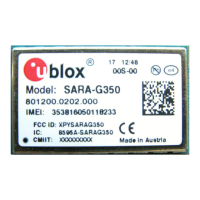SARA-G3 and SARA-U2 series - System Integration Manual
UBX-13000995 - R26 Design-in
Page 167 of 217
2.14 SARA-G3 / SARA-U2 ATEX modules integration in devices intended
for use in potentially explosive atmospheres
2.14.1 General guidelines
SARA-G340 ATEX, SARA-G350 ATEX, SARA-U201 ATEX and SARA-U270 ATEX modules are certified as
components intended for use in potentially explosive atmospheres (see section 4.8 and see the ‘Approvals‘
section of the SARA-G3 series Data Sheet [1] and the SARA-U2 series Data Sheet [2] for further details), with the
following marking:
SARA-G340 ATEX, SARA-G350 ATEX and SARA-U270 ATEX: Ex II 1G, Ex ia IIC/IIB
SARA-U201 ATEX: Ex II 1G, Ex ia IIB
According to the marking stated above, SARA-G340 ATEX, SARA-G350 ATEX, SARA-U201 ATEX and
SARA-U270 ATEX modules are certified as electrical equipment of:
group ‘II’: intended for use in areas with explosive gas atmosphere other than mines susceptible to firedamp.
category ‘1G’: intended for use in zone 0 hazardous areas, in which an explosive atmospheres is caused by
mixtures of air and gases, or when vapours or mists are continuously or frequently present for long periods.
The modules are also suitable for applications intended for use in zone 1 and zone 2 hazardous areas.
level of protection ‘ia’: intrinsically safe apparatus with very high level of protection, not capable of causing
ignition in normal operation and with the application of one countable fault or a combination of any two
countable fault plus those non-countable faults which give the most onerous condition.
subdivision ‘IIB’: intended for use in areas where the nature of the explosive gas atmosphere is considered
dangerous based on the Maximum Experimental Safe Gap or the Minimum Ignition Current ratio of the
explosive gas atmosphere in which the equipment may be installed (typical gases are ethylene, coke oven
gas and other industrial gases), so that the modules are also suitable for applications intended for use in
subdivision IIA (typical gases are industrial methane, propane, petrol and the majority of industrial gases).
subdivision ‘IIC/IIB’: intended for use in areas where the nature of the explosive gas atmosphere is
considered very dangerous based on the Maximum Experimental Safe Gap or the Minimum Ignition Current
ratio of the explosive gas atmosphere in which the equipment may be installed (typical gases are hydrogen,
acetylene, carbon disulphide), so that the modules are also suitable for applications intended for use in
subdivision IIB (typical gases are ethylene, coke oven gas and other industrial gases) and subdivision IIA
(typical gases are industrial methane, propane, petrol and the majority of industrial gases).
The temperature range of use of SARA-G340 ATEX, SARA-G350 ATEX, SARA-U201 ATEX and SARA-U270 ATEX
modules is defined in the ‘Operating temperature range’ section of the SARA-G3 series Data Sheet [1] and the
SARA-U2 series Data Sheet [2].
All these modules are suitable for temperature class T4 applications, as long as the maximum input power does
not exceed 2.5 W on SARA-G340 ATEX and SARA-G350 ATEX modules, or 3.5 W on SARA-U201 ATEX and
SARA-U270 ATEX modules.
Even if SARA-G340 ATEX, SARA-G350 ATEX, SARA-U201 ATEX and SARA-U270 ATEX modules are certified as
components intended for use in potentially explosive atmospheres as described above, the application device
that integrates the module must be approved under all the certification schemes required by the specific
application device that will be deployed in the market as apparatus intended for use in potentially explosive
atmospheres.
The certification scheme approvals required for the application device integrating SARA-G340 ATEX, SARA-G350
ATEX, SARA-U201 ATEX or SARA-U270 ATEX module, intended for use in potentially explosive atmospheres,
may differ depending on the following topics:
the country or the region where the application device must be deployed
the classification of the application device in relation to the use in potentially explosive atmospheres
the classification of the hazardous areas in which the application device is intended for use

